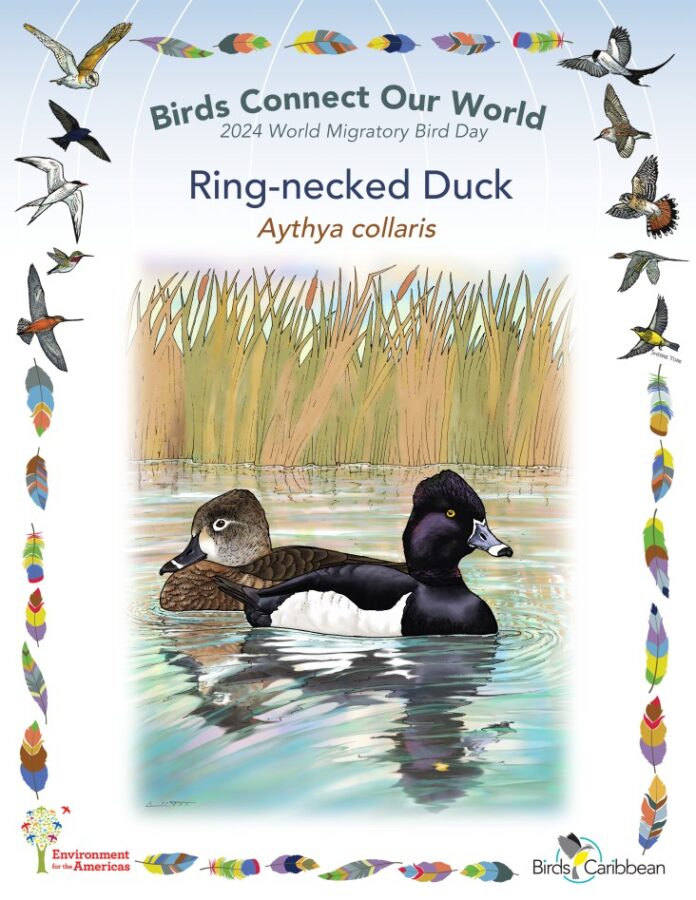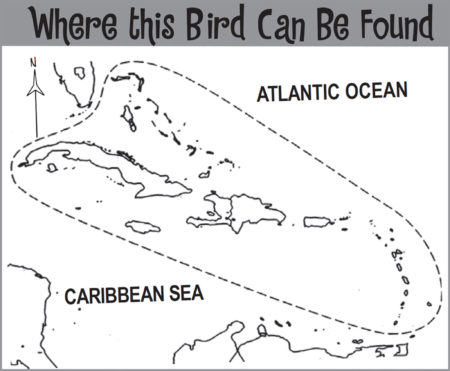Celebrate World Migratory Bird Day (WMBD) with us in 2024! This year’s theme is “Protect Insects, Protect Birds”. Have fun learning about a new migratory bird every day. We have coloring pages, interesting facts, activities, and more. Download for free and enjoy nature with your family at home.
Migratory Bird of the Day: Ring-necked Duck
With such a fab updo and glossy plumage, the Ring-necked Duck is one dashing duck! It is also a strong and fast flier, able to take flight by springing up directly from the water! In contrast, most diving ducks need to do a laborious take-off run before flying off. Although Ring-necked Ducks are diving ducks, they’re frequently seen in shallow waters (four feet deep or less), where patches of open water are fringed with aquatic or emergent vegetation such as sedges and lilies.
Ring-necked Ducks don’t tip up as “dabbling” ducks do, like the elegant Northern Pintails and Blue-winged Teals. They plunge underwater and swim using only their feet for propulsion. The plants they munch on include crunchy leaves, stems, seeds, and tubers from pondweed, water lilies, wild celery, wild rice, millet, sedges, and arrowhead. They also chomp down on snails (shell included!), dragonfly larvae, and even leeches! When it’s time to lay eggs during spring (March through April), these ducks need lots of protein, so they gobble up more bugs and small creatures. In the fall, they switch back to munching on plants during their big migration!
Ring-necked Ducks breed in freshwater marshes and bogs across the boreal forests of northern North America. They build their nests about 10 inches above the water, using bent plant stems, or on floating vegetation. This elevated nesting keeps their eggs safe from land predators like foxes. The female lines the nest with her own down feathers, making it soft and cozy. She typically lays between six and 14 eggs. Ducklings hatch and leave the nest within two days, already able to swim and find food, though they stay under their mother’s watchful eye. As temperatures drop, Ring-necked Ducks migrate to warmer areas, including Central America, northern South America, and the Caribbean. On your island, you’re most likely to spot them in swamps, river floodplains, and reservoirs.
The Ring-necked Duck is named for the chestnut collar across its black neck. This collar is hard to see in the field but it was clearly visible to the nineteenth-century biologists that described the species using dead specimens. Males can instead be identified by their pointed heads, bright yellow eyes, satiny black body, light gray sides, and white wedge at the shoulder. Males have a gray bill with a black tip. Their bills are bordered by a white ring. Females have a gray bill with white band and black tip but no white ring around the bill. Males in eclipse (nonbreeding or “hiding”) plumage, which is worn for a month or more after breeding in the summer, display a browner plumage with brown-black head, breast and back. They differ from the females by having bright yellow eyes and no eye-ring.
Females have a brown-gray body, pale white feathers around the base of the bill, a brown top of the head that contrasts with its gray face, and white eye-ring with a narrow white line that extends back from the eye. Immature ducks resemble their corresponding adult plumages by sex, but they are duller in color.
Ring-necked Ducks and other waterbirds rely heavily on wetlands for breeding, wintering, and migrating. If these vital habitats are threatened, their populations can suffer too. Even if wetlands seem far from where you live, you can still help protect them. Keep your sidewalks, lawns, and driveways free of pet waste, trash, and toxic chemicals like motor oil, which can wash into storm drains and pollute wetlands. Talk to friends and family about the importance of wetlands for both wildlife and people. Also, opt for non-nitrogen lawn fertilizers to prevent nutrient pollution, which can lead to harmful algae blooms and dangerous “dead zones” in water. Your actions can make a big difference in preserving these vital habitats and supporting waterbird populations. Learn more about this species, including its range, photos, and calls here. Great news! If you’re in the Caribbean, thanks to BirdsCaribbean, you have free access to Birds of the World and you can find out even more in the full species account of this bird!
Thanks to Aliya Hosein for the text and Arnaldo Toledo for the lovely illustration!
Color in the Ring-necked Duck
Download the Migratory Birds of the Day Coloring Page! Use the picture above and the photos on this page as your guide, or look up pictures of the bird online or in a bird field guide if you have one. Share your colored-in page with us by posting it online and tagging us @BirdsCaribbean #WMBD2024Carib
Listen to the calls of the Ring-necked Duck
Ring-necked Ducks make a series of short calls consisting of grating barks or grunts.
Enjoy these photos of Ring-necked Ducks
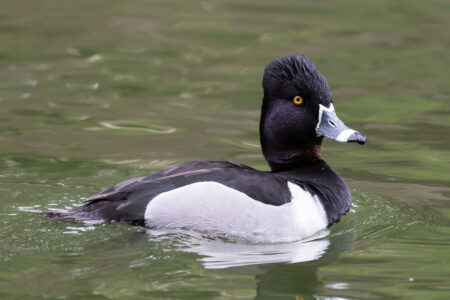
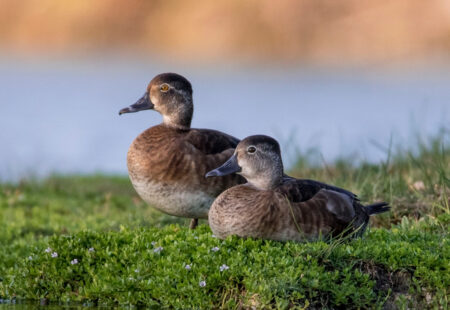
Activity of the Day
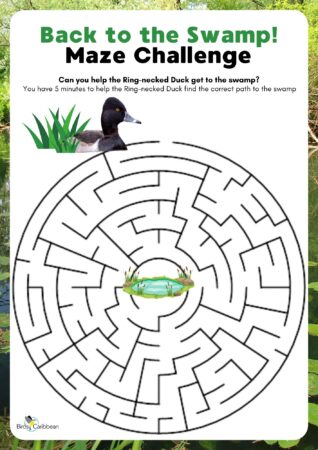 FOR KIDS: During migration, Ring-necked Ducks will stop to rest and feed on shallow lakes with lots of vegetation. Here they will munch on submerged plants and aquatic creatures.
FOR KIDS: During migration, Ring-necked Ducks will stop to rest and feed on shallow lakes with lots of vegetation. Here they will munch on submerged plants and aquatic creatures.
Can you help this tired and hungry Ring-necked Duck get to the swamp to take a rest and grab a snack on its journey south?
You can find the answer here.
When you are out bird watching, look for Ring-neck Ducks in swamps, on floodplains and estuaries, shallow inland lakes, marshes, ponds and reservoirs!
FOR KIDS AND ADULTS: Enjoy this video of Ring-necked Ducks in the wild!

